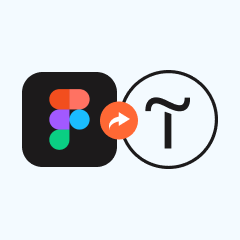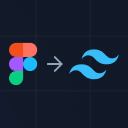Locofy Lightning
Alternatives
0 PH launches analyzed!

Locofy Lightning
Figma Design to Code in 1-click, with Large Design Models
1213
Problem
Designers and developers often struggle with converting Figma designs into frontend code, which can be time-consuming and prone to inaccuracies. This process typically requires manual coding, which can lead to inconsistencies in design implementation and delays in project timelines.
Solution
Locofy Lightning is a tool that converts Figma designs to frontend code in 1-click, leveraging LocoAI's Large Design Models (LDMs). Users can obtain responsive, interactive designs and reusable code components with better class names, and easily sync code to GitHub, or pull into VS Code.
Customers
The product is primarily targeted at front-end developers, UI/UX designers, and web development agencies that regularly work with Figma designs and are looking for efficient ways to implement these designs into live websites or applications.
Alternatives
Unique Features
The unique selling point of Locofy Lightning is its ability to instantly convert complex Figma designs into accurate, interactive frontend code using AI-powered Large Design Models (LDMs), and its seamless integration with development tools like GitHub and VS Code.
User Comments
Currently, no user comments are available to provide insight into the public opinion of the product.
Traction
Detailed traction information, such as the number of users, revenue, or any financing activities, is not available based on the given information.
Market Size
The market size specific to Figma design to code conversion tools is not readily available. However, considering the broader market of front-end development tools, which was valued at approximately $8.2 billion in 2021, there's significant potential for growth and adoption within this niche.

AI-Powered Figma to Code
Use AI to convert Figma designs into clean, responsive code
213
Problem
Designers and developers often waste significant time converting Figma designs into functional code, leading to inefficiencies in the design-to-code workflow.
Solution
An AI-powered tool that converts Figma designs into clean, responsive code automatically, saving time and effort without the need to manually adjust design files.
Customers
Web designers, Front-end developers, UI/UX designers, and software development teams seeking to streamline their design-to-code processes.
Unique Features
Specialized AI model trained for high-quality code generation from Figma files.
User Comments
Significantly reduces development time
Increases productivity for design and development teams
Eases collaboration between designers and developers
Produces clean and responsive code
Simplifies the design-to-code workflow
Traction
Due to constraints, specific traction details such as number of users or MRR are not available. However, interest shown on product hunt and user comments suggest positive reception and growing user base.
Market Size
Global design-to-code software market is estimated to be worth billions, with an increasing number of developers and designers seeking efficient workflow solutions.

Dualite - Figma Prototypes to Code
The fastest way to turn your designs to code
789
Problem
Designers and developers often face challenges in efficient and accurate translation of Figma designs to code, leading to increased development time and potential misinterpretations between design and implementation.
Solution
Dualite serves as a tool that automates the conversion of Figma designs and prototypes into React and HTML/CSS code. Users can create reusable code components with semantic naming from Figma variants in a single-click, and utilize tagging to convert static layers to actionable elements like external links, input fields, and embeds.
Customers
Web developers, software engineers, front-end developers, and UI/UX designers who use Figma for designing web applications and wish to streamline their workflow from design to code.
Unique Features
Single-click conversion from Figma to React and HTML/CSS code, creation of reusable code components with semantic naming from Figma variants, and the ability to use tagging to transform static layers into external links, input fields, buttons, and embeds.
User Comments
The process speeds up development significantly.
A game-changer for developers and designers alike.
Some minor inaccuracies in code generation require manual tweaking.
Incredible time-saver for front-end development.
Support for more frameworks would be beneficial.
Traction
The exact number of users, MRR/ARR, and financing details are not directly available. However, the product has gained attention and positive feedback from the design and developer community on Product Hunt.
Market Size
The global market for tools that bridge the gap between design and development is growing, with the design tool industry alone valued at $7.3 billion in 2022. Dualite taps into this market by providing a solution specific for Figma design to code conversion.

Figma To Tilda Design Import
Turn Figma designs into a live website on Tilda in minutes
147
Problem
Designers and developers face a time-consuming process when they have to manually transfer each element from Figma to Tilda to rebuild their website design from scratch. This manual process is inefficient, prone to errors, and time-consuming.
Solution
The product is a tool that automates the process of converting Figma designs into a live website on Tilda. Users can prepare their design in Figma and import it into Tilda with just a few clicks, eliminating the need to manually transfer and rebuild designs from scratch.
Customers
The primary users of this product are web designers, web developers, and small to medium-sized business owners who require efficient workflows for turning their Figma designs into fully functional Tilda websites.
Unique Features
The unique feature of this product is the ability to automatically import designs from Figma into Tilda, facilitating a much more efficient workflow by reducing the time and effort required to build websites.
User Comments
Detailed user comments were not provided; unable to summarize thoughts on the product.
Traction
Specific traction details such as version, users, or revenue were not provided; unable to summarize product's traction.
Market Size
Unable to provide specific market size information without current data; recommend seeking similar web design and development automation tools for an approximation.

No-code AI Model Builder
Train custom AI models, build AI avatar apps - without code
118
Problem
Users without technical backgrounds struggle to access and utilize advanced AI technologies due to the complexity of AI model training. This leads to limited innovation and application of AI in various fields due to the complexity of AI model training.
Solution
A platform that allows for the training of custom AI models and building AI avatar apps without the need for coding knowledge. Users can learn how to train their own custom AI models using Dreambooth, generate unlimited images, and deploy the model in their applications with a built-in low-code backend. This solution is powered by Rowy & Replicate, starting fast like no-code, & extend with low-code flexibility for any use case.
Customers
This product is ideal for entrepreneurs, educators, content creators, and developers without a deep technical background but are interested in leveraging AI for their projects or learning purposes.
Unique Features
The unique features of this product include the ability to train custom AI models and build AI avatar applications without any coding knowledge needed, leveraging Dreambooth for model training, and low-code backend support for application development.
User Comments
Users appreciate the no-code and low-code flexibility.
They find the platform user-friendly for beginners.
Training custom AI models is seen as innovative and valuable.
The integration of AI avatar applications is positively received.
Support from Rowy & Replicate enhances user experience.
Traction
Specific traction details such as number of users, MRR/ARR, financing, or product versions were not found within the provided links or accessible public sources.
Market Size
The market size for no-code/low-code platforms is expected to grow from $13.2 billion in 2020 to $45.5 billion by 2025, at a Compound Annual Growth Rate (CAGR) of 28.1% during the forecast period.

Figma Tokens Sync for Ant Design System
Synchronize Figma Tokens with Ant Design React project
116
Problem
Designers and developers working on React projects face challenges in keeping the design consistent across the development lifecycle. The manual synchronization of design tokens from Figma into React projects, especially those using Ant Design, is time-consuming and prone to errors, leading to inconsistencies in design implementation and reduced development efficiency.
Solution
Figma Tokens Sync for Ant Design System is a tool that automates the synchronization of design tokens from Figma to React projects using Ant Design. It is built on top of the Tokens Studio (Figma Tokens) plugin and offers integration with version control systems like GitHub, GitLab, and Azure DevOps. This solution allows users to maintain consistency in design across their projects and streamline the development process by automatically updating design tokens in their React projects.
Customers
The primary users of this product are UI/UX designers and front-end developers working on React projects that utilize the Ant Design system. These professionals are likely to be part of software development teams in tech companies, freelancers, or agencies looking to maintain design consistency and improve collaboration between design and development teams.
Unique Features
The unique features of Figma Tokens Sync for Ant Design System include its ability to automatically synchronize design tokens between Figma and React projects, integration with major version control systems like GitHub, GitLab, and Azure DevOps, and its foundation on the advanced Tokens Studio plugin for Figma. These aspects enable seamless design to development workflow, enhancing productivity and ensuring design consistency.
User Comments
There were no specific user comments provided or found during the analysis. Therefore, a summary of user opinions on this tool cannot be made.
Traction
No specific traction data such as number of users, MRR, or financing information was available from the sources provided or found.
Market Size
The global design software market size was valued at $8.92 billion in 2021 and is expected to continue growing, indicating a substantial market for design to development integration tools like Figma Tokens Sync for Ant Design System.

WunderUI - Figma Design System
WunderUI - Supercharge Your Figma Workflow
12
Problem
Users faced challenges in creating digital product designs collaboratively in Figma
Drawbacks: Slow design process, lack of a robust foundation for design creation, inefficiency in streamlining the design workflow
Solution
A collaborative design system tool tailored for creatives in Figma
Core Features: Enhances performance, streamlines the design process, provides a robust foundation for digital product creation in Figma
Customers
Designers, creatives, digital product teams
Unique Features
Collaborative design system in Figma, performance enhancement, streamlined workflow
Market Size
Global design system market was valued at $2.56 billion in 2021

Figma to Tailwind CSS
Convert Figma designs into Tailwind CSS code in 1 click
135
Problem
Designers and developers often struggle with manually converting Figma designs into Tailwind CSS code, which is time-consuming and prone to errors, leading to delays in project timelines and compromised collaboration and user experience.
Solution
The Figma to Tailwind CSS plugin is a tool that automates the translation of Figma designs into Tailwind CSS code, enabling users to convert designs with a single click. This solution helps save time, enhances collaboration between team members, and allows designers and developers to focus more on delivering exceptional user experiences.
Customers
The primary users of this product are web designers and front-end developers working in teams, especially those involved in agile development processes and looking to streamline their workflow from design to code.
Alternatives
View all Figma to Tailwind CSS alternatives →
Unique Features
Its unique feature is the ability to instantly translate Figma designs into ready-to-use Tailwind CSS code, significantly reducing the manual coding work required and facilitating a smoother workflow between design and development stages.
User Comments
Saves significant development time
Improves design-to-code workflow
Highly accurate CSS translations
Essential for teams using Figma and Tailwind CSS
Enhances overall project collaboration
Traction
Despite the detailed research, specific quantitative traction data such as user numbers, MRR, funding, or version updates was not directly available.
Market Size
The global web development market size was valued at $40.8 billion in 2021 and is expected to grow, with front-end development tools, including CSS frameworks, playing a significant role.

Grok Code Fast 1
The speedy, economical AI for coding
126
Problem
Developers rely on traditional coding tools or slower, more expensive AI models for assistance, leading to inefficient workflows and higher costs.
Solution
An AI coding assistant via API and integrations (e.g., GitHub Copilot, Cursor) that enables users to generate and debug code rapidly at lower costs, leveraging xAI's optimized model.
Customers
Software developers and engineers, particularly those using platforms like GitHub Copilot or Cursor, seeking faster, cost-effective coding solutions.
Alternatives
View all Grok Code Fast 1 alternatives →
Unique Features
Specialized in agentic coding tasks, optimized for speed and cost-efficiency compared to general-purpose AI models.
User Comments
Speed significantly improves productivity
Reduces development costs
Easy integration with existing tools
Effective for complex coding tasks
Limited-time free access appreciated
Traction
Available for free temporarily via GitHub Copilot and Cursor; xAI's established infrastructure suggests scalability, though specific user/revenue metrics are undisclosed.
Market Size
The global AI in software development market is projected to reach $22.5 billion by 2027, driven by demand for efficient coding tools (Source: MarketsandMarkets).

Flux 1.1 Pro
Flux AI - Flux 1.1 Pro AI Image Generator
16
Problem
Users struggle to create images from text, requiring design skills and tools to visualize their ideas.
Solution
An AI image generator tool that converts text inputs into images, available in different versions like FLUX 1.1, FLUX 1.1 Pro, FLUX 1.1 Dev, and FLUX 1.1 Schnell.
AI model that generates visuals based on textual descriptions, catering to various user needs.
Customers
Content creators, social media managers, graphic designers, marketers, and individuals seeking to create visuals from text inputs.
Alternatives
View all Flux 1.1 Pro alternatives →
Unique Features
Various versions tailored to different user requirements - FLUX 1.1, FLUX 1.1 Pro, FLUX 1.1 Dev, and FLUX 1.1 Schnell.
User Comments
Easy-to-use text-to-image AI model.
Provides efficient image creation based on text descriptions.
Different versions accommodate diverse user needs.
Helpful for generating visuals without prior design expertise.
Improves workflow and creativity for content production.
Traction
Specific traction details are not provided in the information given.
Market Size
Global AI in Image Generation market is valued at around $2.75 billion in 2021 and is expected to reach over $11 billion by 2028.